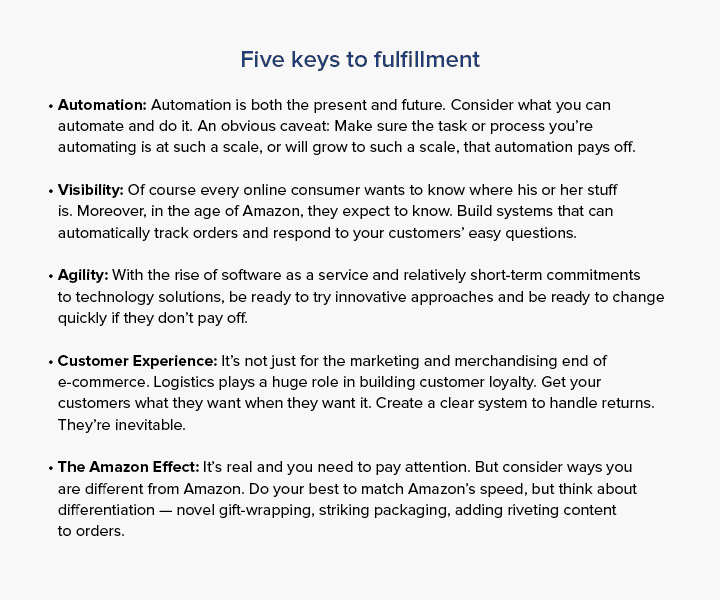Bob Trebilcock grew up on loading docks and in warehouses, tagging along on sales calls with his dad, who worked in the industrial packaging industry, an unglamorous field that is part of the backbone of U.S. manufacturing and distribution.
“I like to say that most dads took their kids to Disney World and my dad took me to the BorgWarner auto parts plant in Buffalo, New York,” Trebilcock says.
So, it’s not crazy that Trebilcock remains fascinated with supply chain and contemplating the challenges and solutions the backstage work presents for thousands of ecommerce retailers from California to Connecticut.
As editorial director of Supply Chain Management Review, Trebilcock has had an up-close view of the dizzying evolution of the process of moving goods and ecommerce orders from here to there. In the era of Amazon, when consumers expect retailers to deliver the goods fast and for free, the pressure on those mapping fulfillment strategy and those executing on those plans is ratcheted up every day.
Five valuable insights on achieving fulfillment from the world of ecommerce
We sat down with Trebilcock to talk about the changes he’s seen in supply chain and ecommerce delivery, where the fields are headed and how those working in ecommerce and distribution can keep up with the rocket ride of filling orders in the 21st century. This interview has been edited for length and clarity.
Q: You’ve been around distribution for years and have been leading Supply Chain Management Review for the past four years. What sorts of changes have you seen in supply chain and delivery in even the past five or 10 years?
A: The biggest change, in broad strokes, is more automation. We’re seeing much more automation. And it doesn’t feel like that’s going away. Everything has been exponential. For years, whenever you went from one point to the next, there was sort of a long period of stability. Now, everything has really started changing at a much faster pace.
There is much more complexity. Things aren’t offered in one size. The same product is offered in 15 or 20 different sizes. And there’s complexity, because for a variety of reasons on the retail side, stores don’t want a lot of inventory. So they just want a pallet that’s got 50 different items on it, and one or two examples of each item, versus a pallet with just one item on it.
And there’s complexity because you and I don’t go to the store anymore. We order (online) a book and a wrench or something. And we want it tomorrow. Complexity in that sense has been driving a lot of the evolution.
Q: Are you seeing other big changes
A: Visibility, meaning whether it’s you or I placing an order or General Motors placing an order to one of its suppliers, everybody wants to know, “Where is my stuff? Where is my order? Did it ship?” If it went by UPS, I want to track it.
Q: Pretty much everybody in ecommerce recites a mantra about “optimizing the customer experience.” The discussion is often in the context of marketing and merchandising, but do the folks on the logistics and fulfillment side of ecommerce have a role to play?

Bob Trebilcock
A: I still use this line every now and then, which is, sales and marketing is the promise-maker. Distribution and transportation, or the supply chain, we’re the promise-keeper. Amazon says, as an Amazon Prime member, you get free next-day delivery. That’s a marketing promise. Well, how are you going to keep that promise?
The way you keep that promise, is you have a system in place that when the order drops, the warehouse can quickly and efficiently pick it and get it onto the back of a truck that goes to the UPS or the FedEx or the post office depot. And then they have a system in place to unload your truck and put it on a conveyor and get it on their truck. That’s all supply chain and without that, that doesn’t happen.
Q: Another thing those in ecommerce talk about a lot — a real lot — is the Amazon effect.
It’s been huge. It’s been huge because Amazon knows how to do it and do it pretty reliably. Therefore, if I’m a customer who is used to shopping from Amazon, when I go to Macy’s or JCPenney or whoever is your favorite retailer, I have the same expectation. So, it’s driving other retailers to do what Amazon does. Other retailers trying to keep up with Amazon are under profit pressures, because it’s expensive. Free shipping, believe it or not, is not free.
Q: Why is Amazon so good at it?
A: I think they’ve been doing it longer than anybody. Many traditional businesses didn’t think that they had to be ecommerce companies in the early days. Think of Borders —what used to be my favorite bookstore and is no longer around. Borders initially was like, “There’s no reason for us to get into the ecommerce business.” And by the time they got into the ecommerce business, they were dead in the water.
Q: Where is supply chain and fulfillment innovation heading?
A: While there’s a lot of really exciting technologies out there, like drones and 3D printing and robots and things, a lot of companies, even big companies, struggle with the meat-and-potatoes, blocking-and-tackling kind of things, like visibility, like connecting their systems.
I think you’re seeing that software is becoming more important than ever. Second, data is the oil of the supply chain. And so, what you’re starting to see is more sensors, meaning devices that can collect data, more sensors at more points in the supply chain to report back. And this goes to that visibility thing, getting data at more and more points in the supply chain and more and more frequently.

Q: So, software, data and a whole lot of better tracking. What else is coming?
A: I just visited, this week, a distribution center in Rochester, New York, that’s one of the first (distribution centers) I’m aware of implementing what are called piece-picking robots. That’s a robot that can go up and down, and all by itself, pick something from a shelf, put it in a basket and then take that basket to what’s called an induction zone, where somebody’s going to take the items in the basket and put it in a shipping container, put the shipping container on a conveyor and then the robot is going to go pick some more.
I don’t think you’re going to see robots tomorrow, other than early adopters. But I think three to five years out, you are going to see more and more robotics because of the labor issue. People are actually pretty good at doing warehouse and distribution work but it’s getting harder and harder to get people who are willing to do the work.
Q: A lot has been written about the role of returned merchandise in ecommerce and what a challenge and cost it is for retailers. Sometimes, when faced with complicated return policies, consumers decide to simply keep the item and get refunds through their credit card companies. Is there a role in the supply chain to reduce the number of returns or the cost?
A: It is a supply chain management problem. It’s called reverse logistics. So yes, it’s huge for, particularly, ecommerce. At one point, a stat that we used to see is like 30 percent of things ordered online were returned. We all want to get something tomorrow. If we return it, we don’t understand why it can’t be returned tomorrow and we can get our money back (tomorrow).
So yeah, returns are huge. And the other thing is, returns are hugely expensive for the retailer because often they’re paying the freight back and then they’ve got to have somebody unpack it and inspect it and figure out whether, is it in good shape, meaning can they resell it as is, or do they need to do something else with it. And going to the Amazon thing, I mean Amazon basically takes most stuff back for free. So it’s a major complication, particularly for retailers.
Q: But what can the distribution end of things do to reduce the likelihood of a return?
A: The only role supply chain has in terms of of preventing returns, is shipping the right product and then getting it there on time. But supply chain can put in automation or technology to speed up the returns process, so that they process it, they decide whether they can resell it, whether I’m owed (a refund) and then give me a refund in a timely fashion. That’s a supply chain issue.
Q: So you and your wife ran Dilly’s for Kids, a brick-and-mortar retail shop, for more than 32 years in Keene, N.H. Did you learn anything about retail from the experience?
A: My wife just retired. We closed the store March 1. She opened Sept. 1, 1984.
The thing that I think that we learned was: My wife really put an emphasis on customer service. Because of the recession, and because of the rise of ecommerce, we had to put a premium on selection. In other words, we carried a lot more inventory and a lot more stuff in the final years than we did in the early years. Because at the end, if they walked in and you didn’t have something they were looking for, they didn’t say, “What else do you got?” They just went online and ordered it.
UPS truck photo by Mike Cassidy. Trebilcock portrait courtesy of Supply Chain Management Review.
Mike Cassidy is Signifyd’s lead storyteller. Contact him at [email protected]; follow him on Twitter at @mikecassidy.








